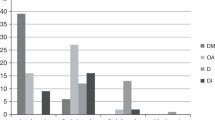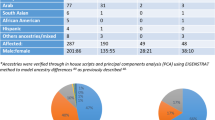Abstract
Genetic predisposition plays an important role in most common psychiatric disorders. The identification of a specific gene associated with a psychiatric illness can lead to improved management of the gene-associated disorder. Mutations in the wolframin gene are associated with mental illness. Many patients with the Wolfram syndrome (WS), who are homozygous or compound heterozygous for wolframin mutations, have severe psychiatric symptoms. In WS families, close blood relatives, who have a high probability of carrying a single wolframin mutation, had a statistically significant excess, over spouse controls, of psychiatric hospitalizations, attempted and completed suicides, and self-reports of mental illness. Since heterozygous carriers of wolframin mutations are relatively frequent in the population according to the general Hardy–Weinberg principle, such mutations might be responsible for the illnesses of many psychiatric patients. The hypothesis that heterozygous carriers of a wolframin mutation are predisposed to psychiatric illness was tested in subjects from 25 WS families. In all, 11 relatives who had psychiatric hospitalizations could be genotyped through mutation analysis. Eight of these carried the wolframin mutation transmitted in their family, significantly (one-sided P=0.0022) more than the 3.0 expected if there were no association between psychiatric hospitalizations and mutations at this locus. All eight mutation-positive subjects had been hospitalized for a major depression. This confirmation of the association is not influenced by confounders, undetected stratification, or genetic heterogeneity. The relative risk of psychiatric hospitalization for depression was estimated to be 7.1 (95% CI 1.9–26.6) for carriers of a single wolframin mutation compared to noncarriers.
This is a preview of subscription content, access via your institution
Access options
Subscribe to this journal
Receive 12 print issues and online access
$259.00 per year
only $21.58 per issue
Buy this article
- Purchase on Springer Link
- Instant access to full article PDF
Prices may be subject to local taxes which are calculated during checkout

Similar content being viewed by others
Accession codes
References
Inoue H, Tanizawa Y, Wasson J, Behn P, Kalidas K, Bernal-Mizrachi E et al. A gene encoding a transmembrane protein is mutated in patients with diabetes mellitus and optic atrophy (Wolfram syndrome). Nat Genet 1998; 20: 143–148.
Strom TM, Hortnagel K, Hofmann S, Gekeler F, Scharfe C, Rabl W et al. Diabetes insipidus, diabetes mellitus, optic atrophy and deafness (DIDMOAD) caused by mutations in a novel gene (wolframin) coding for a predicted transmembrane protein. Hum Mol Genet 1998; 7: 2021–2028.
Swift RG, Sadler DB, Swift M . Psychiatric findings in Wolfram syndrome homozygotes. Lancet 1990; 336: 667–669.
Swift RG, Perkins DO, Chase CL, Sadler DB, Swift M . Psychiatric disorders in 36 Wolfram syndrome families. Am J Psychiatry 1991; 148: 775–779.
Swift RG, Polymeropoulos M, Torres R, Swift M . Predisposition of Wolfram syndrome heterozygotes to psychiatric illness. Mol Psychiatry 1998; 3: 86–91.
Swift M, Swift RG . Psychiatric disorders and mutations at the Wolfram syndrome locus. Biol Psychiatry 2000; 47: 787–793.
Takeda K, Inoue H, Tanizawa Y, Matsuzaki Y, Oba J, Watanabe Y et al. WFS1 (Wolfram syndrome 1) gene product: predominant subcellular localization to endoplasmic reticulum in cultured cells and neuronal expression in rat brain. Hum Mol Genet 2001; 10: 477–484.
Wolfram DJ . Diabetes mellitus and simple optic atrophy among siblings: report of four cases. Staff Proc Mayo Clin 1938; 13: 715–718.
Cremers CWRJ, Wijdeveld PGAB, Pinckers AJLG . Juvenile diabetes mellitus, optic atrophy, hearing loss, diabetes insipidus, atonia of the urinary tract and bladder, and other abnormalities (Wolfram Syndrome). Acta Paed Scand 1977; 264 (Suppl): 3–16.
Kinsley BT, Swift M, Dumont RH, Swift RG . Morbidity and mortality in the Wolfram syndrome. Diabetes Care 1995; 18: 1566–1570.
Swift M, Kupper LL, Chase CL . Effective testing of gene–disease associations. Am J Hum Genet 1990; 47: 266–274.
http://www.khri.med.umich.edu/research/lesperance_lab/lfsnhl.shtml.
van ven Ouweland JM, Cryns K, Pennings RJ, Walraven I, Janssen GM, Maassen JA et al. Molecular characterization of WFS1 in patients with Wolfram syndrome. J Mol Diagn 2003; 5: 88–95.
Torres R, Leroy E, Hu X, Katrivanou A, Gourzis P, Papachatzopoulou A et al. Mutation screening of the Wolfram syndrome gene in psychiatric patients. Mol Psychiatry 2001; 6: 39–43.
Crawford J, Zielinski MA, Fisher LJ, Sutherland GR, Goldney RD . Is there a relationship between Wolfram syndrome carrier status and suicide? Am J Med Genet 2002; 114: 343–346.
Furlong RA, Ho LW, Rubinsztein JS, Michael A, Walsh C, Paykel ES et al. A rare coding variant within the wolframin gene in bipolar and unipolar affective disorder cases. Neurosci Lett 1999; 277: 123–126.
Serretti A, Cusin C, Cristina S, Lorenzi C, Lilli R, Lattuada E et al. Multicentre Italian family-based association study on tyrosine hydroxylase, catechol-O-methyl transferase and Wolfram syndrome 1 polymorphisms in mood disorders. Psychiatr Genet 2003; 13: 121–126.
Kato T, Iwamoto K, Washizuka S, Mori K, Tajima O, Akiyama T et al. No association of mutations and mRNA expression of WFS1/wolframin with bipolar disorder in humans. Neurosci Lett 2003; 338: 21–24.
Sequeira A, Kim C, Seguin M, Lesage A, Chawky N, Desautels A et al. Wolfram syndrome and suicide: evidence for a role of WFS1 in suicidal and impulsive behavior. Am J Med Genet 2003; 119B: 108–113.
Deng H-W . Population admixture may appear to mask, change or reverse genetic effects of genes underlying complex traits. Genetics 2001; 159: 1319–1323.
Emahazion T, Feuk L, Jobs M, Sawyer SL, Fredman D, St Clair D et al. SNP association studies in Alzheimer's disease highlight problems for complex disease analysis. Trends Genet 2001; 17: 407–413.
Marchini J, Cardon LR, Phillips MS, Donnelly P . The effects of human population structure on large genetic association studies. Nat Genet 2004; 36: 512–517.
Middle F, Jones I, McCandless F, Barrett T, Khanim F, Owen MJ . Bipolar disorder and variation at a common polymorphism (A1832G) within exon 8 of the Wolfram gene. Am J Med Genet 2000; 96: 154–157.
Martorell L, Zaera MG, Valero J, Serrano D, Figuera L, Joven J . The WFS1 (Wolfram syndrome 1) is not a major susceptibility gene for the development of psychiatric disorders. Psychiatr Genet 2003; 13: 29–32.
Ohtsuki T, Ishiguro H, Yoshikawa T, Arinami T . WFS1 gene mutation search in depressive patients: detection of five missense polymorphisms but no association with depression or bipolar affective disorder. J Affect Disord 2000; 58: 11–17.
Evans KL, Lawson D, Meitinger T, Blackwood DH, Porteous DJ . Mutational analysis of the Wolfram syndrome gene in two families with chromosome 4p-linked bipolar affective disorder. Am J Med Genet 2000; 96: 158–160.
Athma P, Rappaport R, Swift M . Molecular genotyping shows that ataxia-telangiectasia heterozygotes are predisposed to breast cancer. Cancer Genet Cytogenet 1996; 92: 130–134.
Dork T, Bendix R, Bremer M, Rades D, Klopper K, Nicke M et al. Spectrum of ATM gene mutations in a hospital-based series of unselected breast cancer patients. Cancer Res 2001; 61: 7608–7615.
Li A, Swift M . Mutations at the ataxia-telangiectasia locus and clinical phenotypes of A-T patients. Am J Med Genet 2000; 92: 170–177.
Dork T, Bendix-Waltes R, Wegner RD, Stumm M . Slow progression of ataxia-telangiectasia with double missense and in frame splice mutations. Am J Med Genet 2004; 126A: 272–277.
Acknowledgements
The study of WS families was previously supported by a grant from the G Harold and Leila Y Mathers Charitable Foundation.
Author information
Authors and Affiliations
Corresponding author
Rights and permissions
About this article
Cite this article
Swift, M., Swift, R. Wolframin mutations and hospitalization for psychiatric illness. Mol Psychiatry 10, 799–803 (2005). https://doi.org/10.1038/sj.mp.4001681
Received:
Revised:
Accepted:
Published:
Issue Date:
DOI: https://doi.org/10.1038/sj.mp.4001681
Keywords
This article is cited by
-
Modeling disrupted synapse formation in wolfram syndrome using hESCs-derived neural cells and cerebral organoids identifies Riluzole as a therapeutic molecule
Molecular Psychiatry (2023)
-
Wolfram syndrome: clinical and genetic profiling of a cohort from a tertiary care centre with characterization of the primary gonadal failure
Endocrine (2020)
-
Wolfram Syndrome: Diagnosis, Management, and Treatment
Current Diabetes Reports (2016)
-
Selective cognitive and psychiatric manifestations in Wolfram Syndrome
Orphanet Journal of Rare Diseases (2015)
-
Phenotype Prediction of Pathogenic Nonsynonymous Single Nucleotide Polymorphisms in WFS1
Scientific Reports (2015)



